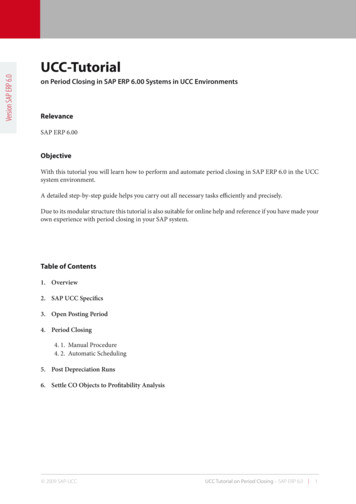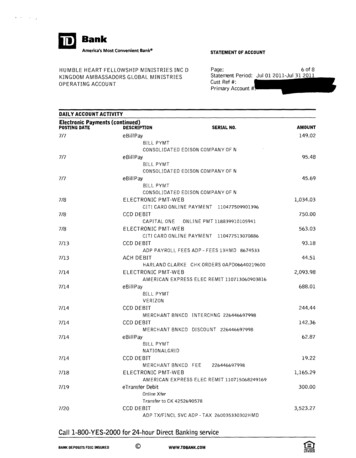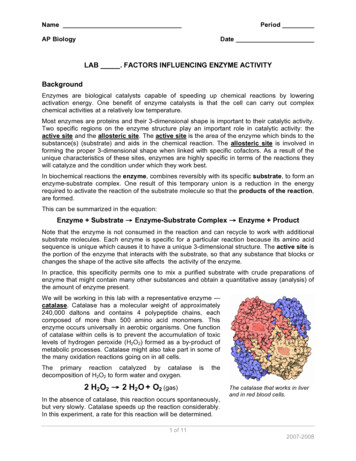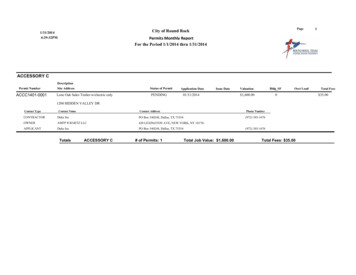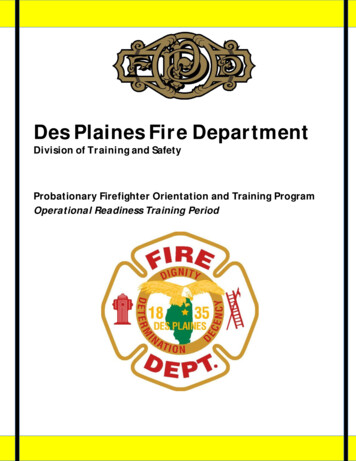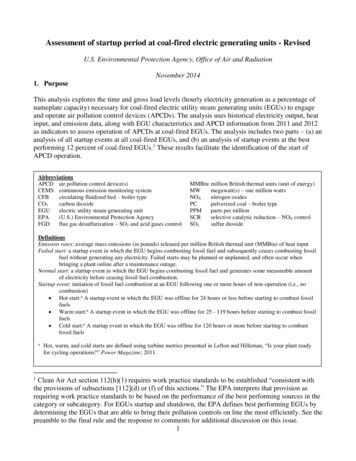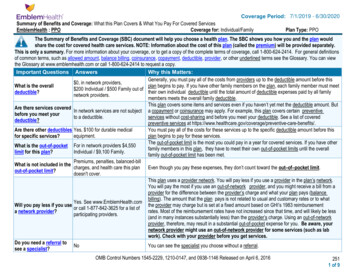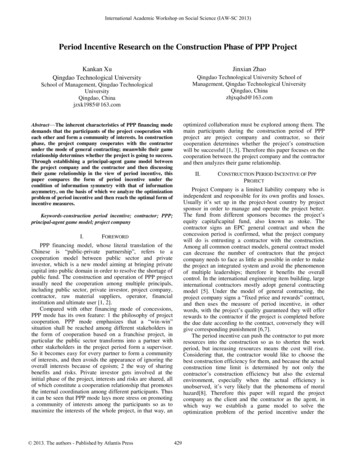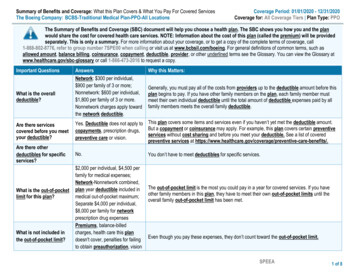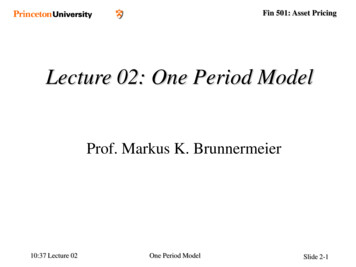
Transcription
Fin 501: Asset PricingLecture 02: One Period ModelProf. Markus K. Brunnermeier10:37 Lecture 02One Period ModelSlide 2-1
Fin 501: Asset PricingOverview1. Securities Structure Arrow-Debreu securities structureRedundant securitiesMarket completenessCompleting markets with options2. Pricing (no arbitrage, state prices, SDF, EMM )10:37 Lecture 02One Period ModelSlide 2-2
Fin 501: Asset PricingThe Economys 1 State space (Evolution of states) Two dates: t 0,1 S states of the world at time t 1 Preferences U(c0, c1, ,cS) 0s 2 s S(slope of indifference curve) Security structure Arrow-Debreu economy General security structure10:37 Lecture 02One Period ModelSlide 2-3
Fin 501: Asset PricingSecurity Structure Security j is represented by a payoff vector Security structure is represented by payoff matrix NB. Most other books use the transpose of X as payoff matrix.10:37 Lecture 02One Period ModelSlide 2-4
Fin 501: Asset PricingArrow-Debreu Security Structure in R2One A-D asset e1 (1,0)c2This payoff cannot be replicated!Payoff Space X c1) Markets are incomplete10:37 Lecture 02One Period ModelSlide 2-5
Fin 501: Asset PricingArrow-Debreu Security Structure in R2Add second A-D asset e2 (0,1) to e1 (1,0)c2c110:37 Lecture 02One Period ModelSlide 2-6
Fin 501: Asset PricingArrow-Debreu Security Structure in R2Add second A-D asset e2 (0,1) to e1 (1,0)c2Payoff space X c1Any payoff can be replicated with two A-D securities10:37 Lecture 02One Period ModelSlide 2-7
Fin 501: Asset PricingArrow-Debreu Security Structure in R2Add second asset (1,2) toc2Payoff space X c1New asset is redundant – it does not enlarge the payoff space10:37 Lecture 02One Period ModelSlide 2-8
Fin 501: Asset PricingArrow-Debreu Security Structure S Arrow-Debreu securities each state s can be insured individually All payoffs are linearly independent Rank of X S Markets are complete10:37 Lecture 02One Period ModelSlide 2-9
Fin 501: Asset PricingGeneral Security StructureOnly bondPayoff space X c2c110:37 Lecture 02One Period ModelSlide 2-10
Fin 501: Asset PricingGeneral Security StructureOnly bond xbond (1,1)Payoff space X can’t be reachedc2c110:37 Lecture 02One Period ModelSlide 2-11
Fin 501: Asset PricingGeneral Security StructureAdd security (2,1) to bond (1,1)c2c110:37 Lecture 02One Period ModelSlide 2-12
Fin 501: Asset PricingGeneral Security StructureAdd security (2,1) to bond (1,1)c2 Portfolio of buy 3 bonds sell short 1 risky assetc110:37 Lecture 02One Period ModelSlide 2-13
Fin 501: Asset PricingGeneral Security Structurec2Payoff space X c1Two assets span the payoff spaceMarket are complete with security structurePayoff space coincides with payoff space of10:37 Lecture 02One Period ModelSlide 2-14
Fin 501: Asset PricingGeneral Security Structure Portfolio: vector h 2 RJ (quantity for each asset) Payoff of Portfolio h is j hj xj h’X Asset span X is a linear subspace of RS Complete markets X RS Complete markets if and only ifrank(X) S Incomplete marketsrank(X) S Security j is redundant if xj h’X with hj 010:37 Lecture 02One Period ModelSlide 2-15
Fin 501: Asset PricingIntroducing derivatives Securities: property rights/contracts Payoffs of derivatives derive from payoff ofunderlying securities Examples: forwards, futures, call/put options Question:Are derivatives necessarily redundant assets?10:37 Lecture 02One Period ModelSlide 2-16
Fin 501: Asset PricingForward contracts Definition: A binding agreement (obligation) to buy/sellan underlying asset in the future, at a price set today Futures contracts are same as forwards in principle exceptfor some institutional and pricing differences A forward contract specifies: The features and quantity of the asset to be delivered The delivery logistics, such as time, date, and place The price the buyer will pay at the time of deliveryExpirationdateToday10:37 Lecture 02One Period ModelSlide 2-17
Fin 501: Asset PricingSettlement price(last transaction of the day)Low of the dayReading price quotesIndex futuresLifetime highHigh of the dayThe open priceDaily changeOpen interestExpiration month10:37 Lecture 02Lifetime lowOne Period ModelSlide 2-18
Fin 501: Asset PricingPayoff diagram for forwards Long and short forward positions on the S&R 500 index:10:37 Lecture 02One Period ModelSlide 2-20
Fin 501: Asset PricingForward vs. outright purchaseForward payoffBond payoff Forward bond Spot price at expiration - 1,020 1,020 Spot price at expiration10:37 Lecture 02One Period ModelSlide 2-21
Fin 501: Asset PricingAdditional considerations (ignored) Type of settlement Cash settlement: less costly and more practical Physical delivery: often avoided due to significant costs Credit risk of the counter party Major issue for over-the-counter contracts Credit check, collateral, bank letter of credit Less severe for exchange-traded contracts Exchange guarantees transactions, requires collateral10:37 Lecture 02One Period ModelSlide 2-22
Fin 501: Asset PricingCall options A non-binding agreement (right but not an obligation) tobuy an asset in the future, at a price set today Preserves the upside potential ( ), while at the same timeeliminating the unpleasant ( ) downside (for the buyer) The seller of a call option is obligated to deliver if askedExpirationdateTodayorat buyer’s choosing10:37 Lecture 02One Period ModelSlide 2-23
Fin 501: Asset PricingDefinition and Terminology A call option gives the owner the right but not theobligation to buy the underlying asset at a predeterminedprice during a predetermined time period Strike (or exercise) price: The amount paid by the optionbuyer for the asset if he/she decides to exercise Exercise: The act of paying the strike price to buy the asset Expiration: The date by which the option must beexercised or become worthless Exercise style: Specifies when the option can be exercised European-style: can be exercised only at expiration date American-style: can be exercised at any time before expiration Bermudan-style: can be exercised during specified periods10:37 Lecture 02One Period ModelSlide 2-25
Fin 501: Asset PricingReading price quotesS&P500 Index optionsStrike price10:37 Lecture 02One Period ModelSlide 2-26
Fin 501: Asset PricingPayoff/profit of a purchased call Payoff max [0, spot price at expiration – strike price] Profit Payoff – future value of option premium Examples 2.5 & 2.6: S&R Index 6-month Call Option Strike price 1,000, Premium 93.81, 6-month risk-free rate 2% If index value in six months 1100 Payoff max [0, 1,100 - 1,000] 100 Profit 100 – ( 93.81 x 1.02) 4.32 If index value in six months 900 Payoff max [0, 900 - 1,000] 0 Profit 0 – ( 93.81 x 1.02) - 95.6810:37 Lecture 02One Period ModelSlide 2-27
Fin 501: Asset PricingDiagrams for purchased call Payoff at expiration10:37 Lecture 02 Profit at expirationOne Period ModelSlide 2-28
Fin 501: Asset PricingPut options A put option gives the owner the right but not theobligation to sell the underlying asset at a predeterminedprice during a predetermined time period The seller of a put option is obligated to buy if asked Payoff/profit of a purchased (i.e., long) put: Payoff max [0, strike price – spot price at expiration] Profit Payoff – future value of option premium Payoff/profit of a written (i.e., short) put: Payoff - max [0, strike price – spot price at expiration] Profit Payoff future value of option premium10:37 Lecture 02One Period ModelSlide 2-30
Fin 501: Asset PricingA few items to note A call option becomes more profitable when the underlyingasset appreciates in value A put option becomes more profitable when the underlyingasset depreciates in value Moneyness: In-the-money option: positive payoff if exercised immediately At-the-money option: zero payoff if exercised immediately Out-of-the money option: negative payoff if exercised immediately10:37 Lecture 02One Period ModelSlide 2-33
Fin 501: Asset PricingOptions and insurance Homeowner’s insurance as a put option:10:37 Lecture 02One Period ModelSlide 2-34
Fin 501: Asset PricingEquity linked CDs The 5.5-year CD promises to repay initial invested amountand 70% of the gain in S&P 500 index: Assume 10,000 investedwhen S&P 500 1300 Final payoff S final 10,000 1 0.7 max 0, 1 1300 Fig. 2.14 where Sfinal value of theS&P 500 after 5.5 years10:37 Lecture 02One Period ModelSlide 2-35
Fin 501: Asset PricingOption and forward positionsA summary10:37 Lecture 02One Period ModelSlide 2-36
Fin 501: Asset PricingOptions to Complete the MarketStock’s payoff:( state space)Introduce call options with final payoff at T:10:37 Lecture 02One Period ModelSlide 2-37
Fin 501: Asset PricingOptions to Complete the MarketTogether with the primitive asset we obtainHomework: check whether this markets are complete.10:37 Lecture 02One Period ModelSlide 2-38
Fin 501: Asset PricingGeneral Security Structure Price vector p 2 RJ of asset prices Cost of portfolio h, If pj 0 the (gross) return vector of asset j is thevector10:37 Lecture 02One Period ModelSlide 2-39
Fin 501: Asset PricingOverview1. Securities Structure(AD securities, Redundant securities, completeness, )2. Pricing LOOP, No arbitrage and existence of state pricesMarket completeness and uniqueness of state pricesPricing kernel q*Three pricing formulas (state prices, SDF, EMM)Recovering state prices from options10:37 Lecture 02One Period ModelSlide 2-40
Fin 501: Asset PricingPricing State space (evolution of states)(Risk) preferencesAggregation over different agentsSecurity structure – prices of traded securitiesProblem: Difficult to observe risk preferences What can we say about existence of state priceswithout assuming specific utilityfunctions/constraints for all agents in the economy10:37 Lecture 02One Period ModelSlide 2-41
Fin 501: Asset PricingVector Notation Notation: y,x 2 Rn y x , yi xi for each i 1, ,n. y x , y x and y x. y x , yi xi for each i 1, ,n. Inner product y x i yx Matrix multiplication10:37 Lecture 02One Period ModelSlide 2-42
Fin 501: Asset PricingThree Forms of No-ARBITRAGE1. Law of one price (LOOP)If h’X k’X then p h p k.2. No strong arbitrageThere exists no portfolio h which is a strongarbitrage, that is h’X 0 and p h 0.3. No arbitrageThere exists no strong arbitragenor portfolio k with k’ X 0 and p k · 0.10:37 Lecture 02One Period ModelSlide 2-43
Fin 501: Asset PricingThree Forms of No-ARBITRAGE Law of one price is equivalent toevery portfolio with zero payoff has zero price. No arbitrage) no strong arbitrageNo strong arbitrage ) law of one price10:37 Lecture 02One Period ModelSlide 2-44
Fin 501: Asset PricingPricing Define for each z 2 X , If LOOP holds q(z) is a single-valued and linearfunctional. (i.e. if h’ and h’ lead to same z, then price has to be the same) Conversely, if q is a linear functional defined in X then the law of one price holds.10:37 Lecture 02One Period ModelSlide 2-45
Fin 501: Asset PricingPricing LOOP ) q(h’X) p h A linear functional Q in RS is a valuationfunction if Q(z) q(z) for each z 2 X . Q(z) q z for some q 2 RS, where qs Q(es),and es is the vector with ess 1 and esi 0 if i s es is an Arrow-Debreu security q is a vector of state prices10:37 Lecture 02One Period ModelSlide 2-46
Fin 501: Asset PricingState prices q q is a vector of state prices if p X q,that is pj xj q for each j 1, ,J If Q(z) q z is a valuation functional then q is a vectorof state prices Suppose q is a vector of state prices and LOOP holds.Then if z h’X LOOP implies that Q(z) q z is a valuation functional, q is a vector of state prices and LOOP holds10:37 Lecture 02One Period ModelSlide 2-47
Fin 501: Asset PricingState prices qp(1,1) q1 q2p(2,1) 2q1 q2Value of portfolio (1,2)3p(1,1) – p(2,1) 3q1 3q2-2q1-q2 q1 2q2c2q2c1q110:37 Lecture 02One Period ModelSlide 2-48
Fin 501: Asset PricingThe Fundamental Theorem of Finance Proposition 1. Security prices excludearbitrage if and only if there exists a valuationfunctional with q 0. Proposition 1’. Let X be an J S matrix, andp 2 RJ. There is no h in RJ satisfying h p · 0,h’ X 0 and at least one strict inequality if,and only if, there exists a vector q 2 RS withq 0 and p X q.No arbitrage , positive state prices10:37 Lecture 02One Period ModelSlide 2-49
Fin 501: Asset PricingMultiple State Prices q& Incomplete MarketsWhat state prices are consistentwith p(1,1)?p(1,1) q1 q2Payoff space X One equation – two unknowns q1, q2There are (infinitely) many.e.g. if p(1,1) .9p(1,1)q1 .45, q2 .45or q1 .35, q2 .55bond (1,1) onlyc2q2c1q110:37 Lecture 02One Period ModelSlide 2-50
Fin 501: Asset PricingQ(x)x2complete markets X qx110:37 Lecture 02One Period ModelSlide 2-51
Fin 501: Asset Pricingp XqQ(x)x2 X incomplete marketsqx110:37 Lecture 02One Period ModelSlide 2-52
Fin 501: Asset Pricingp XqoQ(x)x2 X incomplete marketsqox110:37 Lecture 02One Period ModelSlide 2-53
Fin 501: Asset PricingMultiple q in incomplete marketsc2 X p X’qq*qovqc1Many possible state price vectors s.t. p X’q.One is special: q* - it can be replicated as a portfolio.10:37 Lecture 02One Period ModelSlide 2-54
Fin 501: Asset PricingUniqueness and Completeness Proposition 2. If markets are complete, under noarbitrage there exists a unique valuation functional. If markets are not complete, then there existsv 2 RS with 0 Xv.Suppose there is no arbitrage and let q 0 be a vectorof state prices. Then q a v 0 provided a is smallenough, and p X (q a v). Hence, there are an infinitenumber of strictly positive state prices.10:37 Lecture 02One Period ModelSlide 2-55
Forward bond Spot price at expiration - 1,020 1,020 Spot price at expiration Forward payoff Bond payoff. Fin 501: Asset Pricing 10:37 Lecture 02 One Period Model Slide 2-22 Additional considerations (ignored) Type of settlement Cash settlement: less costly and more practical Physical delivery: often avoided due to significant costs Credit risk of the counter party Major .

